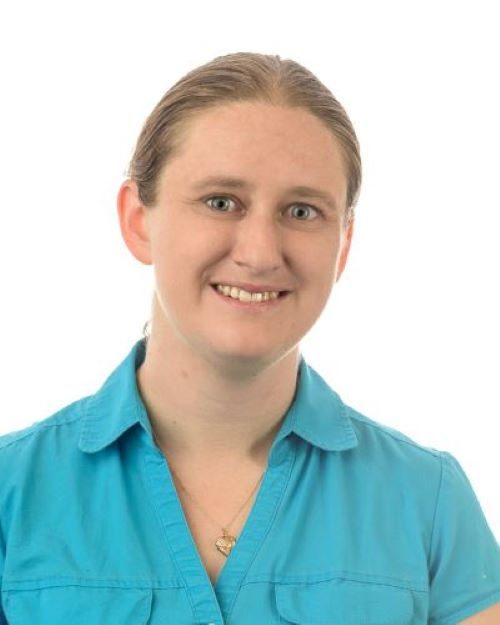Leslie Mertz for the American Chemical Society
Adopters of alternative grading see it as offering something that traditional grading does not: a shift in student motivation away from chasing percentage points on quizzes and tests, and toward learning the material. "Because of the way alternative grading is structured around learning objectives and really meeting those learning objectives, it has refocused the conversations I have with students. Instead of students asking 'How do I get 5 more points on this quiz so I can get to the next grade level?', they now center on the material, so they ask me things like 'How do I draw resonance structures?'" said Kristi Closser, Ph.D., assistant professor in the Department of Chemistry and Biochemistry at California State University, Fresno (also known as Fresno State).
Closser began offering her approximately 20-student Introductory Physical Chemistry course (CHEM 108) using alternative grading in 2018 after using a related alternative grading approach in a first-semester organic chemistry course with materials borrowed from colleague Hubert Muchalski, Ph.D. Closser is the lead author of a 2024 Journal of Chemistry Education article chronicling lessons learned about the grading strategy in CHEM 108 over a five-year period (2018-2022). "Overall, my sense is that alternative grading gives students a more foundational level of knowledge across physical chemistry topics. That focus on the material vs. the grade is what has sold me on alternative grading, and why I haven't gone back to traditional grading," she said.
Alternative grading also works in larger classes, said Joseph Houck, Ph.D., associate teaching professor in Penn State's Department of Chemistry. He began trying the approach in his 250- to 470-student organic chemistry courses a year ago. "Although is only my second academic year using it, I am already hearing from my students that they feel like they are learning the content really well, and they're seeing the growth in themselves, too."
What is alternative grading?
Alternative grading encompasses a variety of strategies. Houck and Closser chose variations of specifications grading (often shortened to specs grading). Here, they divide a course into learning modules or topics, design quizzes to assess proficiency in each topic, allow students the choice of retaking quizzes to improve proficiency, and figure the satisfactory completion of quizzes into the students' final grades.
Specs grading and other non-traditional strategies, sometimes grouped together under the umbrella term "ungrading," are all ways to encourage students to actively participate and find joy in learning, according to Christina Katopodis, Ph.D., senior postdoctoral research associate at the City University of New York (CUNY) Humanities Alliance at the CUNY Graduate Center, and co-author of The New College Classroom, a how-to book on student-centered teaching.
"We've been schooled to believe that student learning requires external motivators, including rewards, such as good grades, and consequences, such as academic probation, the threat of having to retake course, or other scare tactics," Katopodis explained. "But studies in The Proceedings of the National Academy of Sciences (PNAS) and other journals have repeatedly shown that these external motivators can undermine students' internal motivators — things like curiosity, emotional connection, and the desire to help other people — that actually do drive them to learn. This is why scenarios that focus on internal motivators are important."
Besides specs grading, chemistry instructors might consider other alternative-grading strategies. Self-assessment and narrative feedback would be good options, Katopodis said. In these, students might write two cover letters: an initial letter introducing themselves and their background (including chemistry-related education), describing their career aspirations, and listing three learning goals for the semester and how they can reach them. "The idea is to help the student connect to their internal motivators, and to give you or perhaps your teaching assistants an opportunity to offer advice and mentorship," she said. Near the end of a course, students assess their progress toward their three goals in a second cover letter, and give themselves a grade. "This helps the students become self-directed learners," she said. (Katopodis offers more detail on self-assessment in her blog.)
Peer evaluation is another strategy that would fit well with a chemistry lab, Katopodis said. After putting students into lab groups, the instructor might ask the students to write initial job descriptions so their roles are clearly defined, and evaluate both themselves and other lab members throughout the course. "This is a highly effective way to assess group work, and elevates all of the essential skills employers look for: communication, collaboration, listening, synthesizing information, and summarizing," she said, noting that The New College Classroom explores job descriptions and the wide range of student-driven assessment strategies in detail.
Two takes on specs grading
Closser and Houck provided a closer look at the specs-grading approaches used in their courses.
For her CHEM 108 course, Closser separated the material into nine main topics or modules she wanted students to take away from the course, and requires students to show proficiency in all nine to pass the class. Rather than giving one quiz per module and grading it on a conventional percent scale (90 percent correct is an A, 80 is a B, etc.), she issues grades based on a different formula: quizzes are divided into two types of questions, multiple-choice and short answer, and each section is scored as satisfactory or unsatisfactory. A satisfactory score on all nine multiple-choice sections is required to pass the course, and the number of satisfactory scores on short-answer sections distinguishes an A, B, C, or D grade. Generally, students achieve satisfactory scores for roughly 70-75% of the questions answered correctly, depending on the specific number of questions (e.g., students are told 7/10 or 3/4 questions must be fully correct for a satisfactory score). To improve their grade, students have an option to retake the written quiz, and if needed, to try again via an oral quiz, and possibly an additional oral quiz, or quizzes, if Closser believes they need further study in certain areas.
"I've experimented with different formats, and this works in this class for a few reasons," she said. "For one, it helps from an instructor perspective, because I only need to write two versions of the quizzes for each module. And from a student perspective, even though the oral quiz is generally a very friendly exchange between me and the student — I basically just walk the student through a previous quiz and probe their knowledge to make sure they understand the material rather than memorizing answers — the oral quiz still really terrifies them, so it serves as a bit of motivator itself."
Beyond the quizzes for each module, Closser also prepares a cumulative final with questions drawn from the module quizzes, and grades the final with 70 percent as the cutoff for an A. "It is more relaxed than the traditional 90 percent, and that's because I consider the final more as a knowledge check, or a secondary demonstration of knowledge," she said.
Houck does things a bit differently in his classes. His first-semester organic course is divided into 23 major topics. Students ‘complete’ a topic if they pass one quiz and ‘demonstrate proficiency’ in the topic by passing a second quiz. "I do that to ensure students know the material rather than just getting lucky and to show retention of the information over a period of time," he said. There are 5 opportunities for quizzes over the semester. The first two are offered in a recitation associated with the course, the second two during scheduled, outside-of-class "quiz hours," and the fifth at the end of the course. Rather than giving a cumulative final exam, Houck uses that period to allow students the fifth retake for as many of the topics as they like.
"To get an A in my class, students have to complete (pass one quiz) all 23 topics and be proficient (pass a second quiz) in 19 of the 23 topics; to get a B, they have to pass some fewer number; and so on. The goals are very tangible," Houck said. For example, if students must show proficiency in 12 topics to get a C, the students know what they have accomplished, and so does the instructor. "In a traditionally graded course, by comparison, students are shooting for 70 percent to get a C, but they have no idea what that looks like in terms of what they have to learn, and I don't know what they have actually learned. That's a big difference," Houck said.
His specs-grading course has many benefits, Houck said, but it does demand a bit more effort. To administer and grade up to 115 quizzes per class, Houck relies on both his teaching assistants and a bit of automation in the form of Gradescope software that not only helps with grading and feedback, but also supplies him with student-progress data. The initial organization of the course also took some extra time. "I was fortunate to be supported by our College of Science through a Teaching Innovation Grant, so I had a couple of weeks to prep the course initially, doing things like defining the number and scope of the topics, and creating the rubrics," he said. "In addition, there's the ongoing writing of quizzes, which takes me about 4-5 hours a week." Nonetheless, he said, "The extra time commitment is worth it. Now that I've tried specs grading in class, I am all in. I won't go back."
Final thoughts
Katopodis encouraged other chemistry instructors to think about trying an alternative grading strategy themselves, because learning blossoms when curiosity and joy are the motivators rather than fear of a bad grade or having to retake a course, she said. "We need to stop using grades as the carrot at the end of the stick, and tap into the wonderful reasons people give for wanting to learn something new: they're curious, they want to improve themselves, they want to help other people." She added, "After all, isn't the point of an education for everyone to learn and to be successful?"




